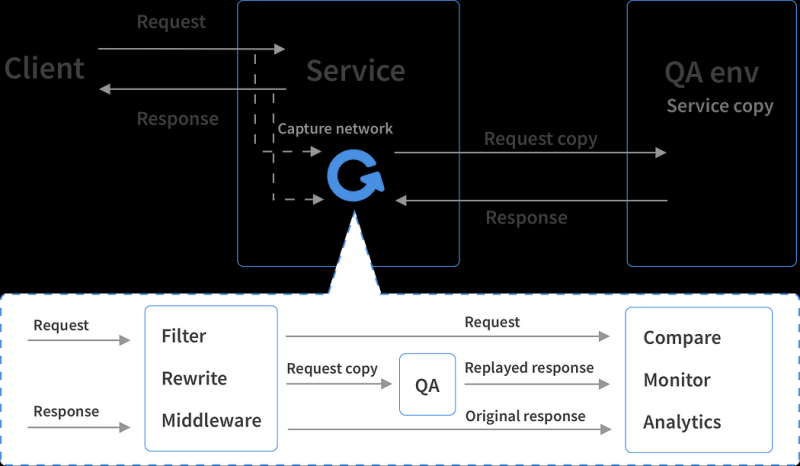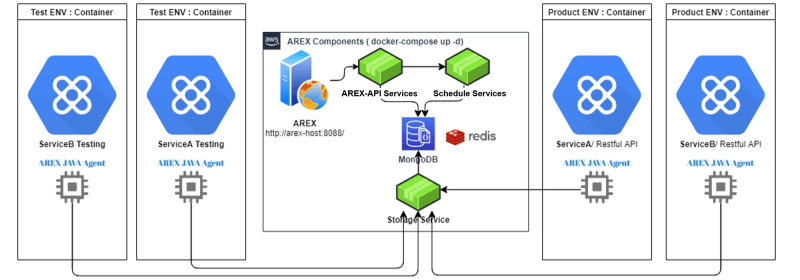
AREX or GoReplay: Choosing the Right Tool for Effective Traffic Replay

As software applications grow more complex, encompassing elements like microservices, containers, and...
As software applications grow more complex, encompassing elements like microservices, containers, and intricate connections, predicting and manually scripting test cases for every conceivable scenario has turned into a formidable challenge. The conventional methodology, which involves the creation and validation of test cases, demands significant manual labor and the upkeep of extensive script libraries. This traditional approach is increasingly seen as labor-intensive and less feasible in the dynamic landscape of modern software development.
Nevertheless, the advent of Production traffic replay has revolutionized the process of testing and validating applications. This innovative approach facilitates the replication of actual production traffic, enabling the realistic simulation and thorough exercise of real-world scenarios. By capturing and replaying network traffic, this method offers a streamlined path to accelerate the testing process. More importantly, it instills greater confidence in the modifications applied to the application, ensuring they perform robustly in live environments.
This approach offers several distinct advantages compared to conventional test case generation:
- Produces tests that are more representative of real-world scenarios.
- Significantly lessens the cognitive effort needed to devise test cases.
- Uncovers potential bugs that might remain undetected in a controlled testing environment.
- Utilizes a diverse range of data for more comprehensive testing.
Several tools capable of capturing production traffic, such as GoReplay and AREX, are already available in the market. Both AREX and GoReplay highlight this feature prominently as a unique selling point. Therefore, this comparison will primarily focus on how each product leverages production traffic capture.
Traffic replay or traffic mirroring?
Gor implements production traffic replay through a technique known as traffic mirroring. This method involves shadowing live user traffic and redirecting it to a test environment. This can be done either in real-time or asynchronously using systems like Apache Kafka, file systems, and other such platforms.

AREX is a testing platform for traffic replay, which involves recording the live traffic from online environment and replaying it to the test environment for API testing.

The traffic replay mechanism employed by AREX, while similar to traffic mirroring, presents some key distinctions:
- Persistence of Traffic Data:Unlike traffic mirroring, which doesn’t store the captured traffic, AREX's approach allows for the retention and replay of traffic at any desired moment. This feature is particularly beneficial for testing scenarios like Black Friday traffic surges.
- Application Validation:Traffic mirroring lacks built-in application validation, requiring developers to write their own, often brittle and single-use, validation checks. In contrast, AREX addresses this gap.
- Data Sanitization:Raw data captured through traffic mirroring typically requires sanitization to address issues such as authentication, timestamp adjustments, and the protection of sensitive information. AREX considers this essential step, ensuring the suitability of data for use in lower-level environments, a process often overlooked in basic traffic mirroring.
Ease of getting started
GoReplay is renowned for its straightforward setup process. Implementation is as simple as downloading a binary, involving fewer initial steps than AREX. However, when delving deeper into its usage, it becomes apparent that GoReplay lacks certain functionalities found in more specialized testing tools. This is especially noticeable when compared to AREX, which is purpose-built for API testing and offers a more comprehensive set of features.
A significant distinction lies in GoReplay's lack of a WebUI, necessitating interaction with the tool predominantly via the terminal. This contrasts sharply with AREX, which boasts a WebUI, offering a more intuitive and user-friendly interface. This graphical interface simplifies the management and configuration of the tool, enhancing the overall user experience.
Reliability
In the assessment of traffic replay solutions, reliability — the consistent replay of traffic — is a critical factor. It's crucial to understand that GoReplay operates differently from a proxy. Instead, it implements a system-level hook that records all HTTP socket traffic occurring on a specified port. Once this traffic is captured, replaying it involves using a command that is almost identical to the one used for recording:
// capture traffic
gor --input-raw :8000 --output-file ./requests.gor
// replay the traffic
gor --input-raw :80 --output-http "http://target_server:8080"
While GoReplay natively integrates with Kafka for data storage, this setup presents notable limitations. Specifically, when using Kafka, data must be recorded and replayed simultaneously, which can compromise reliability.
In contrast, AREX emerges as a more comprehensive tool, offering seamless integration of traffic recording and playback with automated testing. It supports the replay of recorded data at any time and multiple times, enhancing both flexibility and reliability in its use.
Data sensitivity
Capturing production traffic often involves dealing with sensitive user information, necessitating stringent measures for data anonymization or removal during the capture process. In the case of Gor, its traffic mirroring approach results in the collection of raw data, which initially lacks sanitization, potentially raising security concerns during its operation.
Conversely, for users who place a high priority on data security, AREX stands out with its strong commitment to storing only desensitized data. This approach substantially increases the safety and privacy protection of the captured traffic.
API mocking
AREX distinguishes itself from GoReplay by offering the valuable ability to modify recorded data. This feature grants users the flexibility to tailor and adjust captured traffic to suit specific testing requirements. Such a capability is crucial for simulating diverse scenarios and edge cases, thereby elevating the comprehensiveness of your testing strategy.

On the other hand, GoReplay primarily concentrates on replaying captured traffic in its original form, lacking inherent functionality to alter the data during the replay phase.
Identify regressions and changes
With Gor, there's a necessity to author middlewares, for tasks such as comparing original and replayed data, monitoring latency fluctuations, and producing analytics from this data. This can add layers of complexity to the testing process.
In contrast, AREX not only provides traffic recording and playback features but also includes built-in comparison functionalities. These integrated features in AREX simplify the process of contrasting original and replayed data, monitoring performance changes, and extracting insightful analytics, streamlining the overall testing workflow.
AREX or Goreplay?
In conclusion, when deciding between AREX and GoReplay for traffic replay, the choice hinges on specific testing requirements and preferences. GoReplay offers simplicity and a straightforward approach, making it suitable for scenarios where basic traffic replay is needed without additional complexities. AREX, on the other hand, shines with its advanced features like data sanitization, traffic modification, and built-in comparison capabilities, catering to more intricate testing scenarios. Ultimately, the decision should align with your project’s needs, balancing simplicity against a comprehensive set of features for thorough and effective testing.

